
Scoliosis affects six to nine million people in the United States. It’s often diagnosed in children or teens between 10 and 15. However, adults can develop degenerative scoliosis that may impact mobility and overall health.
Read what our Center for the Functional Restoration of the Spine (CFRS) team says about the health problems connected to scoliosis and the treatments we offer to resolve this potentially debilitating condition.
Understanding scoliosis
Scoliosis occurs when the spine curves from side to side (laterally) and, in most cases, twists or rotates. Depending on the degree of curvature, your shoulders, ribcage, waist, and hips may align unevenly.
Most cases of childhood scoliosis are mild, but the curve can worsen over time and requires careful monitoring. Bracing may help slow the progression of childhood scoliosis, which typically stabilizes once your spine reaches maturity. More girls than boys develop scoliosis, and the cause is frequently unknown.
Adult-onset scoliosis is different, however, because it’s frequently caused by degenerative changes in the facet joints, intervertebral discs, and other structures in the spine that affect its stability.
Other causes of adult-onset scoliosis include a progression of the spinal curvature after treatment during adolescence or worsening of the curve in people who did not require or receive treatment when younger.
What health complications does scoliosis cause?
Individuals with scoliosis often experience problems with self-confidence and lowered self-esteem due to the visible effects of scoliosis. This is especially true for children and adolescents who have a significant curvature.
Moderate-to-severe scoliosis also causes various physical effects, including progressive back pain that may eventually affect mobility and the ability to participate in physical activity. A severe curvature can also cause the ribcage to press against your lungs, making breathing difficult and increasing your risk of pulmonary problems.
Adult-onset scoliosis related to spinal degeneration often occurs in the lower back and can eventually cause spinal canal narrowing (stenosis). This common cause of nerve entrapment may lead to muscle weakness, numbness, and radiating pain into the hips, buttocks, and legs.
How do you treat scoliosis?
Scoliosis treatment varies and depends on the type and degree of spinal curvature. For instance, very mild curvatures noted in childhood require careful monitoring but may never progress far enough for further care.
Childhood scoliosis that’s progressive or significant may respond well to bracing. Most scoliosis braces are designed for wear 16-24 hours a day. About 80% of individuals who wear their braces as directed have good results.
Adults experiencing nerve compression or chronic pain related to scoliosis may require surgery. The surgical team at CFRS specializes in minimally invasive spine surgeries that provide excellent results with smaller incisions and quicker healing time than traditional or “open” procedures.
Children who do not respond well to bracing and adults whose previous surgery has failed also require surgery, typically spinal fusion, to prevent worsening of the scoliotic curve.
For more information about scoliosis or any of the treatments we offer, schedule an evaluation at CFRS today. Call one of our three New Jersey locations or request an appointment online.

